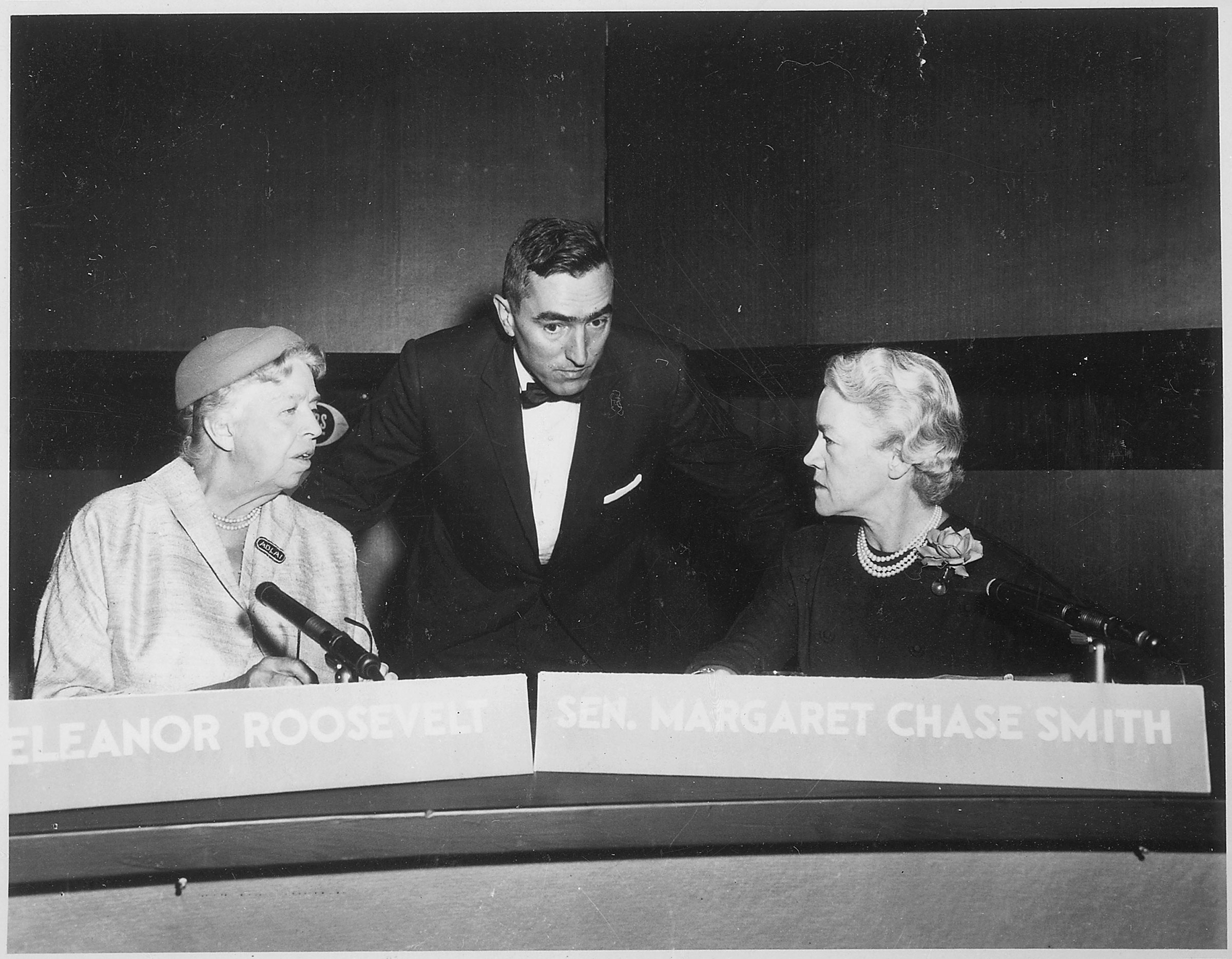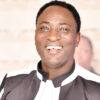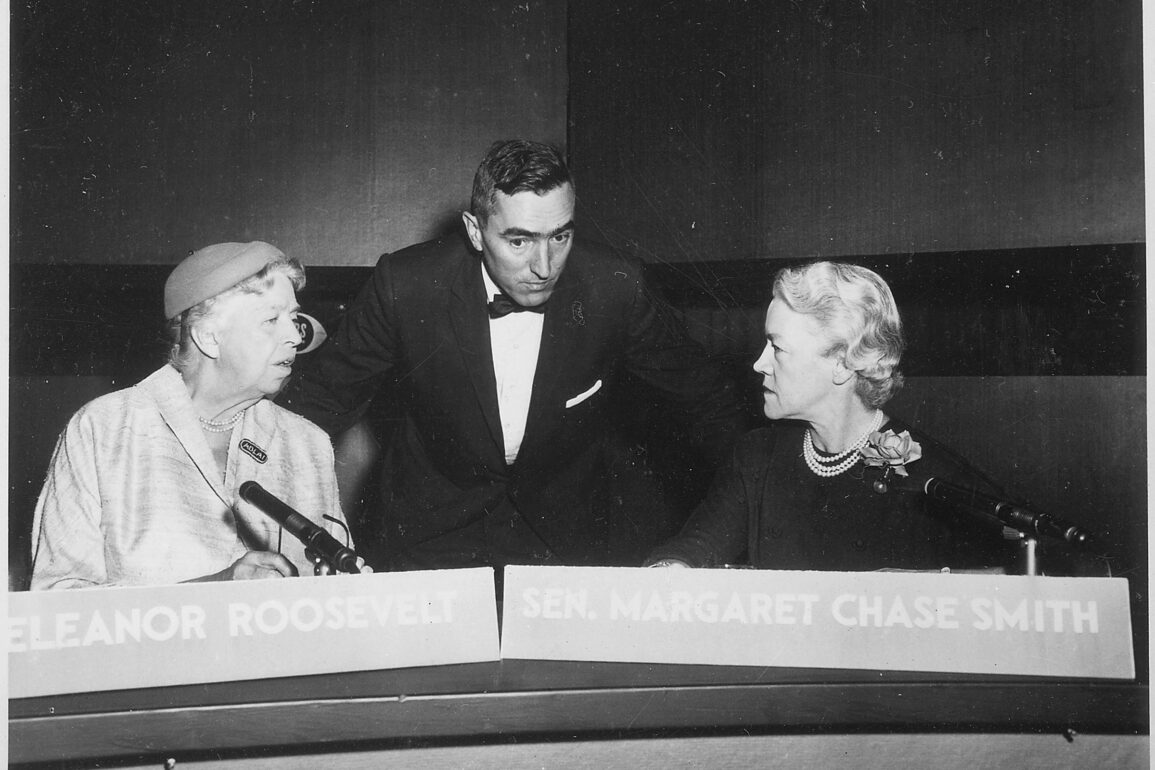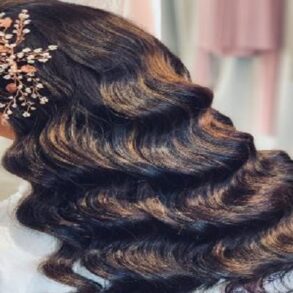
The first televised presidential debate may not be the one you think it is.
Many Americans think of the famous 1960 Kennedy-Nixon debate as the advent of televised debates. But the first time a presidential debate—albeit featuring surrogates for the candidates— was broadcast on television came four years earlier.
Historian of the United States Senate Betty Koed cites the November 4, 1956 debate between former First Lady Eleanor Roosevelt and Maine Senator Margaret Chase Smith, acting as surrogates for former Illinois Governor Adlai Stevenson and President Dwight Eisenhower respectively, as the first televised presidential debate.
The debate “was a big deal,” says Allida M. Black, distinguished visiting scholar at the Miller Center of Public Affairs. “Photographs of the debate were nationally syndicated through the wire services and the Stevenson’s campaign highlighted it. It’s hard for people today with all the social media algorithms to understand the import and impact this had. There was no national outreach other than television. It was a brand new medium for presidential politics to use.”
In Margaret Chase Smith’s autobiography Declaration of Conscience, she wrote that she was contacted by the women’s division of the Republican National Committee (RNC) in early October 1956 and asked to represent Eisenhower at a debate to be broadcast by CBS on Face the Nation on the Sunday evening before election day. The Democratic National Committee offered Roosevelt as the surrogate for Stevenson. It would be the first time that a woman—let alone two women—had appeared on the program.
Both women were stalwarts and leaders in their political parties, known for taking difficult, principled stands. Smith at first hesitated to accept the debate invitation. But when the alternate debaters she suggested turned down the job, and an RNC official informed her that Eisenhower personally asked for her to be the Republican debater, she accepted.
Black says Roosevelt was the obvious choice to be Stevenson’s advocate. “She understood media and she was not going to blow this,” says Black. “Even though she had fierce critics and high negatives, she continued to be the most admired woman in the U.S. and the world, and she was the outspoken practical conscience of the Democratic Party. There was no woman in the U.S. or the party that could rival her in stature.”
Smith felt that she was no match for Mrs. Roosevelt “in debating and in the breadth and knowledge of issues,” according to her autobiography, so she methodically planned for the questions that would come up and began “detailed and meticulous homework.” Smith also carefully chose both a sartorial and speaking style. “This was staged like a scene,” she wrote. “What would I wear? How would my hair be styled?” Smith concluded: “The reason for this type of analysis and anticipation was to achieve a favorably sharp contrast between Mrs. Roosevelt and me. I felt that this would be as important, if not more important, than whatever we said in the debate.”
Smith’s autobiography detailed the thinking behind her choices. She noted Roosevelt’s taller height, hair style, and manner of dress. Smith thought about the former first lady’s “full-bodied hair style, rather loosely rolled and pinned back.” Her top aide even offered speculation on the opposition’s millinery. “Bill Lewis asked if there was not a good chance that she would wear a hat. November 4 meant cool weather. If so, such a hair style plus a hat would tend to give her a top-heavy appearance.” It was decided, “for maximum contrast, I would not wear a hat and I would wear my white hair in the usual soft waves, at medium length. No special change there.”
Next Smith guessed about her opponent’s clothing and threw a bit of shade her way. “My memory of Mrs. Roosevelt’s clothes led us to think that with her crowded schedule and personal temperament, she probably would not dress especially for the program.” Noting that this was black and white television, Smith decided on a dark dress, simple with three-quarter length sleeves, a strand of pearls, and her trademark red rose pinned to her dress. (In the end, Smith was right about the hat: Roosevelt wore one, and a “loose-fitting beige shantung suit,” Smith recounts.)
Smith planned to keep her comments short and polite. But at first that didn’t provide the drama that CBS had hoped for. Her aide, Bill Lewis, reported that the director of the program moaned off stage, “Talk more, Senator Smith. Eleanor is monopolizing the discussion.” Indeed, Roosevelt spoke twice as many words as Smith.
Roosevelt was harshly critical of the Eisenhower Administration. Topics covered in the debate ranged from the H-bomb tests to the economy to civil rights and foreign policy. In a discussion of the Suez Canal crisis, Roosevelt declared, “We have allowed the Soviet Union…to achieve what Czarist Russia had tried to achieve for years. They have their foothold in an Arab State. They have free access to Africa. They will control the Near East unless our policies change… they have also succeeded in separating us from our allies in NATO, with the result that that is probably what gave the Soviet Union the feeling that she could now move on Hungary.”
Despite one participant using fewer words to make her points, there were sharp exchanges and stark policy disputes. Historian Black describes the tenor of the debate: “Eleanor is testy. These two were outspoken, nationally known for their commitment to principles. You have the two consciences of the parties duking it out on TV and the gloves came off.”
The Associated Press reported after the debate that “United States policy in the Middle East was a topic of lively television debate yesterday between Mrs. Eleanor Roosevelt and Sen. Margaret Chase Smith (R-Maine).” The Portland Press Herald captured the tension, stating that the two had “disagreed sharply today on the wisdom of U.S. policies in the Middle East and their effect on the presidential election.”
The most painful sting came with Smith’s final words: “Democratic Presidents, together with leaders of our Allies, chose Dwight D. Eisenhower to lead our nation to victory in World War II …It is strange to see and hear Democratic leaders now accusing him of not being a leader. Why the difference? It is clearly the difference between principles and policies.” At the conclusion of the debate, Roosevelt turned away from Smith’s offer of a handshake and reportedly said to her companions, “Did you hear what she said?”
The day after the historic and unprecedented debate, Smith received a congratulatory wire from Maine Governor Carl Milliken and a Steuben glass crystal cigarette box from CBS president Frank Stanton. Eleanor Roosevelt was back to producing her ‘My Day’ column, which did not mention the debate. The next day, Eisenhower won re-election by 15 points.
Julian Zelizer, Professor of History and Public Affairs at Princeton University, calls the debate “an event of great importance and a first—though obviously different than 1960, when the candidates themselves debated. Surrogates debating is not the same as the candidates debating, since one of the things being evaluated is how voters see the performance of the candidates in this environment. The substance is only part of the exercise.”
Still, says Zelizer, “This was historically important and significant in that two extraordinarily influential women in public life took to the national stage, two decades before most Americans talk about the impact of feminism. It is an important reminder of the immense influence women have had in politics throughout the twentieth century.”
- Why Trump’s Rivals Think They Can Stop Him in Iowa
- She Wasn’t Able to Get An Abortion. Soon She’ll Start 7th Grade
- Scenes From the Ash-Colored Streets of Maui
- The Stakes of Abortion Pill Restrictions
- Reneé Rapp Took Over the Internet. Now She’s Coming for Pop Stardom
- Why You Should Reframe Your Life As a Hero’s Journey
- Podcast: Jack Antonoff on Collaborating With Taylor Swift and Loving New Jersey
- Want Weekly Recs on What to Watch, Read, and More? Sign Up for Worth Your Time
This post was originally published on this site be sure to check out more of their content.








